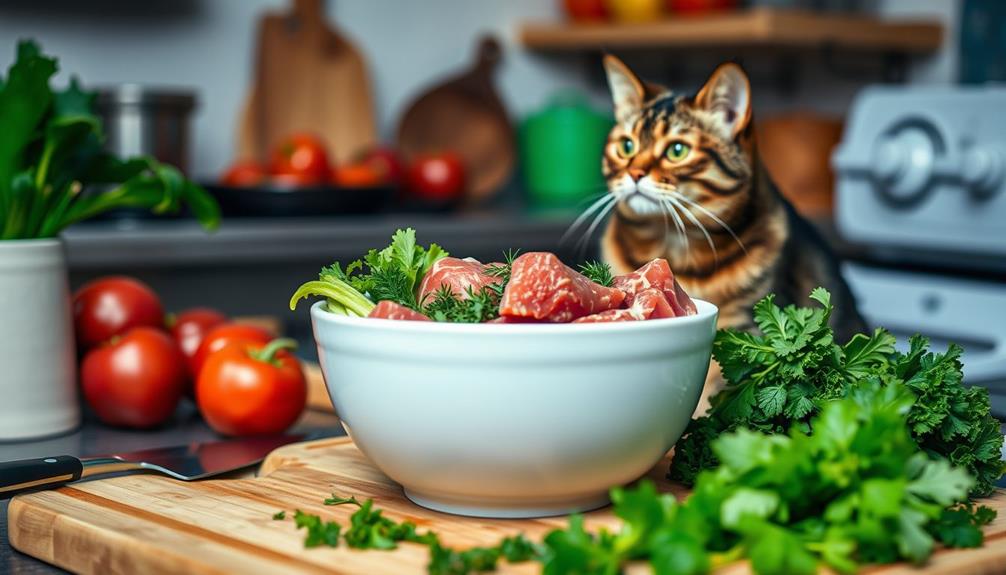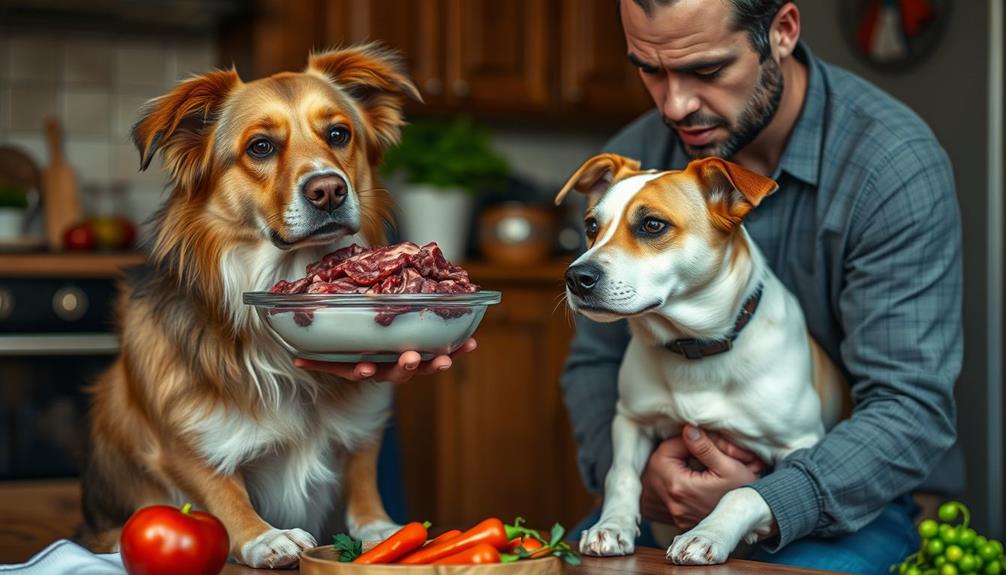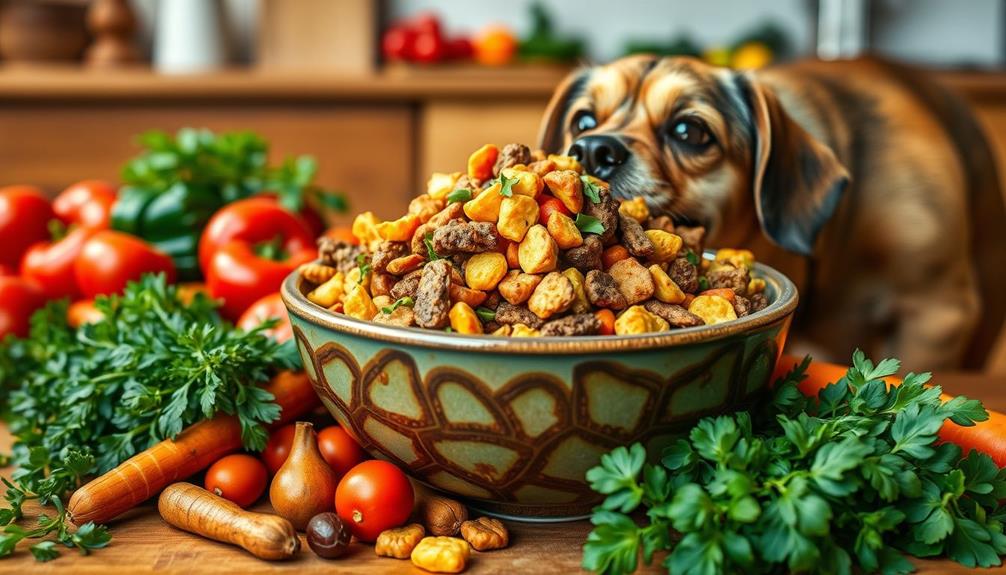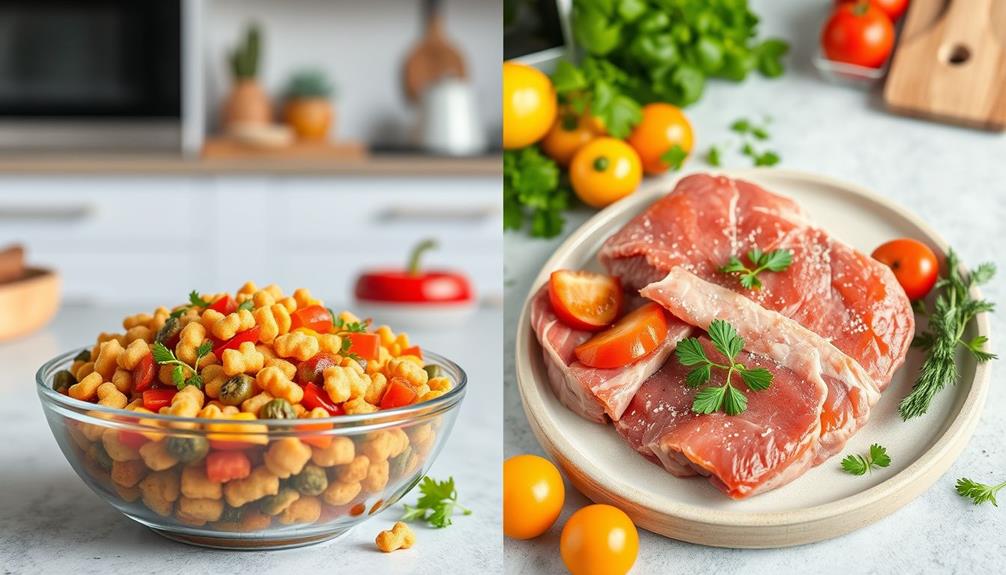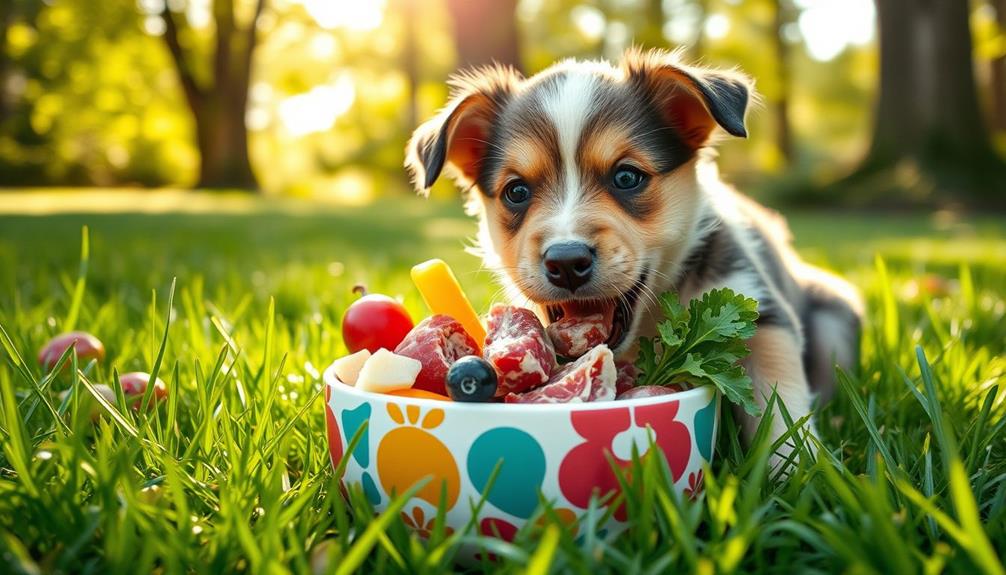Yes, you can feed cats raw food, but it comes with challenges. A raw diet mimics what wild cats eat, providing high-quality protein and supporting dental and digestive health. However, you must be cautious about nutritional balance and food safety. Homemade raw diets can lead to deficiencies, while commercial options often meet essential AAFCO guidelines. Bacterial contamination poses risks too, so proper sanitation is vital. If you're considering this for your cat, it's wise to consult a veterinarian for guidance. You'll also discover tips on preparing and adapting to a raw diet that suits your feline's needs. For some cats, transitioning to a raw diet may be challenging, and they may require time to adjust to the new texture and taste. It’s important to monitor their reaction and consult with a veterinarian if there are any concerns. Additionally, introducing raw food slowly and in small portions can help minimize digestive upset for cats and raw food.
Key Takeaways
- A raw food diet mimics a cat's natural diet, providing high-quality protein and essential nutrients for overall health.
- Benefits include improved dental health, better hydration, and enhanced digestion, aligning with the nutritional needs of obligate carnivores.
- Health risks include bacterial contamination and potential nutritional deficiencies, making veterinary guidance crucial for safe feeding.
- Gradual transitioning to raw food is recommended to avoid digestive upset, starting with a mix of old and new food.
- Commercial raw diets from reputable brands comply with AAFCO guidelines, ensuring balanced nutrition and reduced foodborne pathogen risks.
What Is a Raw Food Diet?
A raw food diet for cats consists of uncooked animal products like muscle meat, organ meat, and ground bones, closely mimicking what wild felines eat. By providing raw muscle meat and other uncooked animal products, you can offer your cat a diet rich in high-quality protein.
This approach aims to deliver complete and balanced nutrition, essential for their overall health. It's worth mentioning that a raw food diet can have its own set of challenges, such as guaranteeing proper food safety and avoiding nutritional gaps, which can be addressed by consulting a veterinarian.
When considering a raw food diet, it's essential to verify that it includes all necessary nutrients. Homemade raw diets often lack critical components unless guided by a veterinarian. To avoid nutritional gaps, you might want to explore commercial raw diets.
These products are formulated to meet AAFCO guidelines, guaranteeing they provide complete and balanced nutrition while also addressing safety concerns.
Commercial raw diets often include ingredients like chicken, fish, and eggs, all of which supply high-quality animal protein. Plus, these diets typically have a high moisture content, aiding in hydration and supporting kidney health.
Whether you go homemade or commercial, prioritizing a raw food diet can bring your cat closer to the natural dietary habits of their wild ancestors, promoting better health and energy.
Benefits of Raw Food for Cats
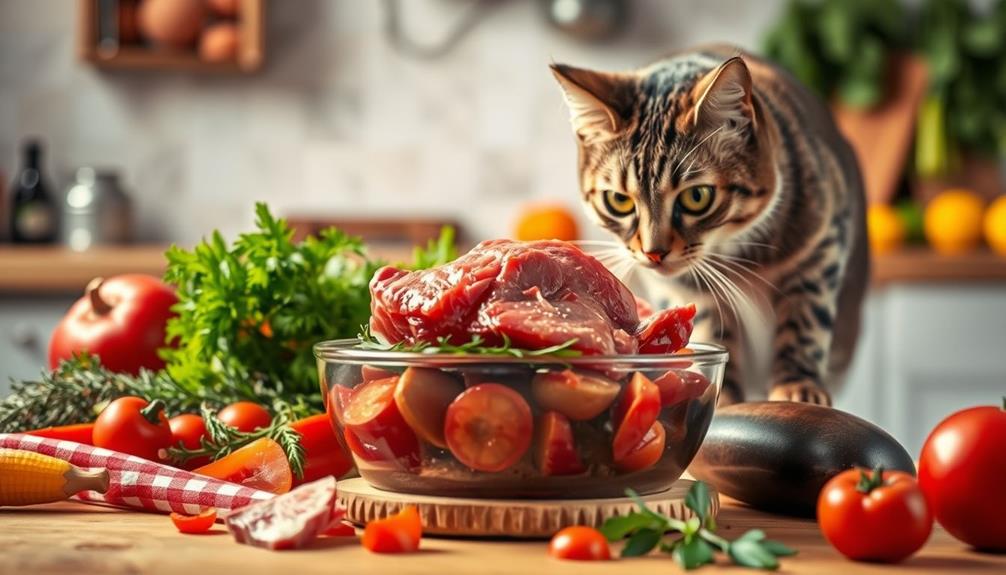
Switching your cat to a raw food diet can offer a range of health benefits that align closely with their natural dietary needs. As obligate carnivores, cats thrive on diets rich in animal-sourced proteins.
Additionally, ensuring a balanced diet is essential for your cat's overall well-being, much like the proper diet for hamsters that includes essential nutrients.
Here are three key benefits of feeding raw food to your feline friend:
- Improved Dental Health: The natural chewing action involved in consuming raw food can help reduce tartar buildup and promote better oral hygiene.
- Enhanced Hydration: With high moisture content, raw food can boost your cat's hydration levels, which is essential for urinary tract health and may help prevent kidney disease.
- Better Digestion and Nutrient Absorption: Raw food diets are often less processed, allowing for improved digestion and higher nutrient content, which means your cat can get more out of their meals.
Safety of Raw Food Diets
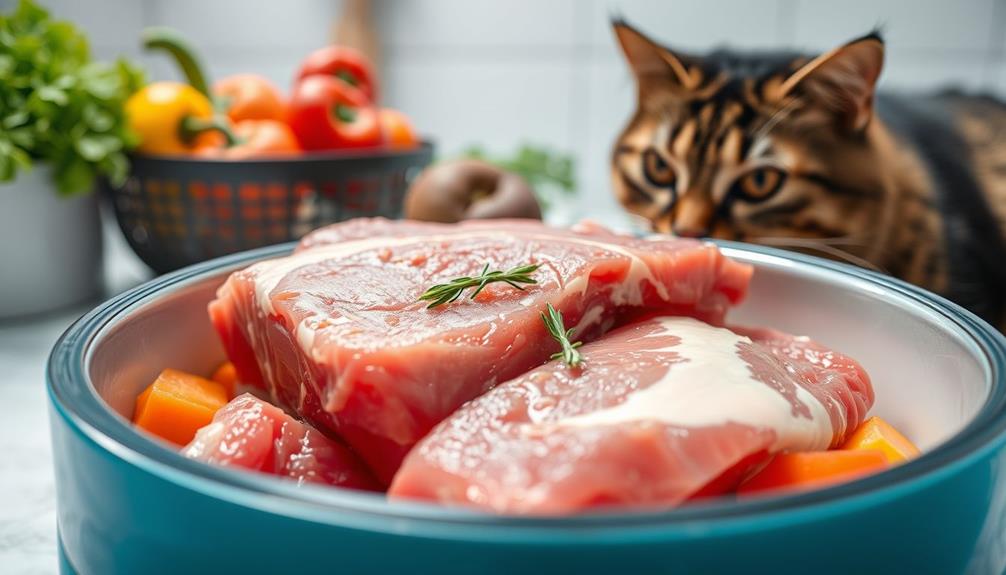
Feeding your cat a raw food diet can pose significant safety concerns that you shouldn't overlook. One of the biggest risks is bacterial contamination from pathogens like Salmonella and E. coli, which can lead to serious health issues for your cat and even affect humans in your household.
Researching potential risks associated with raw diets is vital for making informed decisions. Homemade raw diets are particularly risky since they may lack essential nutrients, resulting in imbalances that can negatively impact your cat's health.
While commercially prepared raw cat foods are formulated to meet AAFCO guidelines, ensuring they're complete and balanced, they still require careful handling. The CDC and AVMA recommend exercising caution when considering raw food diets due to the potential health risks.
To minimize cross-contamination, you should practice proper food safety, including sanitizing preparation areas and using gloves when handling raw foods.
Consulting with your veterinarian is essential to create a safe feeding plan that considers these health concerns. Remember, the safety of your pet and your family should always come first when it comes to raw food diets.
Nutritional Balance in Raw Diets
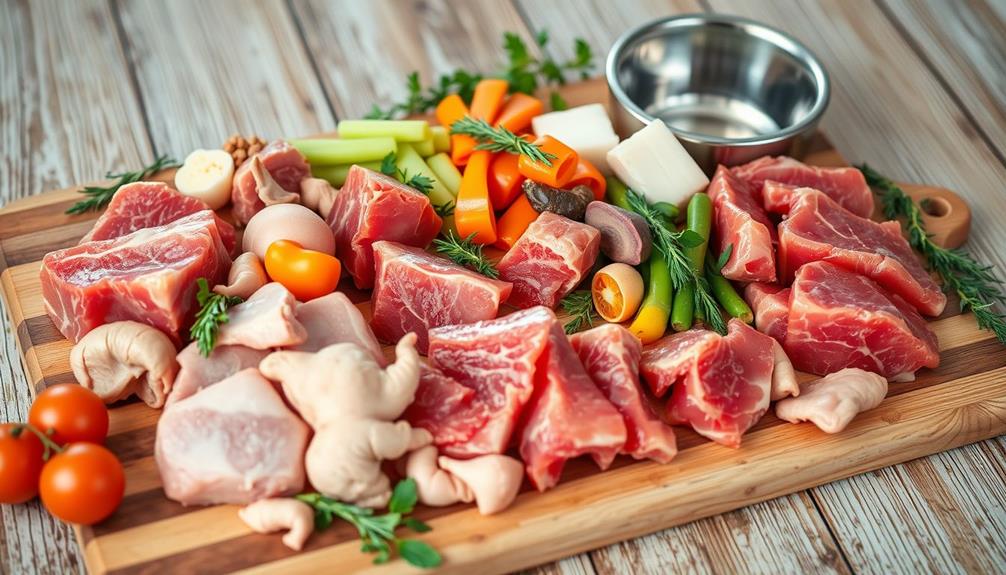
When it comes to feeding your cat a raw diet, nutritional completeness is vital to their health.
It's important to be aware of cold medications overview that might interact with their diet or health. Without proper balance, you risk serious deficiencies that can lead to significant health issues.
Regularly consulting with a veterinarian or pet nutritionist can help guarantee your cat's raw meals meet their specific needs.
Importance of Nutritional Completeness
Achieving nutritional completeness in a raw food diet for your cat is crucial for their health and well-being.
Since cats are obligate carnivores, they require specific nutrients that must be present in a complete and balanced raw diet. Without careful planning, nutritional deficiencies can arise, leading to serious health issues.
To guarantee your cat's raw diet is nutritionally complete, consider these three key points:
- Follow AAFCO Guidelines: Make certain your cat's diet meets the AAFCO nutrient guidelines required for their life stage.
- Include Essential Nutrients: Incorporate crucial vitamins and minerals that support overall health, which may be lacking in homemade diets.
- Consult a Veterinarian: Regular consultations with a veterinarian or pet nutritionist can help you formulate a diet that remains nutritionally adequate.
Risks of Nutritional Deficiencies
Nutritional deficiencies can pose serious risks in a raw food diet if you don't carefully balance the ingredients. Cats require a specific mix of nutrients, and without a complete and balanced diet, you might inadvertently deprive your feline friend of essential vitamins and minerals.
For instance, deficiencies in thiamine and taurine can lead to severe health issues, including neurological problems and a weakened immune system. To effectively manage your cat's nutrition, consider implementing a budget plan for high-quality ingredients, as budgeting for pet care can help guarantee you provide the best diet possible.
When formulating homemade raw diets, you may struggle to meet the AAFCO guidelines for complete and balanced nutrition. Commercially prepared raw diets are typically better at providing the necessary nutrients, while homemade options often require additional supplementation.
If you overlook this balance, your cat might show signs of poor coat condition, lethargy, or even chronic diseases.
To avoid these risks, regular veterinary consultation is vital. A vet can help guarantee your cat's raw diet meets all nutritional needs and prevent potential deficiencies that could impact their overall health.
Role of Veterinary Guidance
How can you confirm your cat's raw food diet is both safe and nutritious? The answer lies in seeking veterinary guidance.
Collaborating with a veterinarian or a veterinary nutritionist guarantees your cat receives balanced nutrition that meets the AAFCO nutrient guidelines. This professional input is vital, as many homemade raw diets can lack essential vitamins and minerals, leading to nutrient deficiencies that can harm your cat's health.
Additionally, just like maintaining a balanced diet for overall health effective strategies for weight loss is important, so is confirming your cat's diet is nutritionally sound.
Here are three reasons to prioritize veterinary guidance when formulating a raw food diet for your cat:
- Prevent Nutrient Deficiencies: A vet can help identify and correct any potential deficiencies, such as thiamine, that could adversely affect your cat's well-being.
- Guarantee Balanced Nutrition: Professionals can assist in creating meals that cover all the nutritional bases, promoting ideal health.
- Monitor Health: Regular veterinary check-ups allow you to track your cat's health and dietary response, making timely adjustments to the raw diet as needed.
Health Risks of Raw Diets
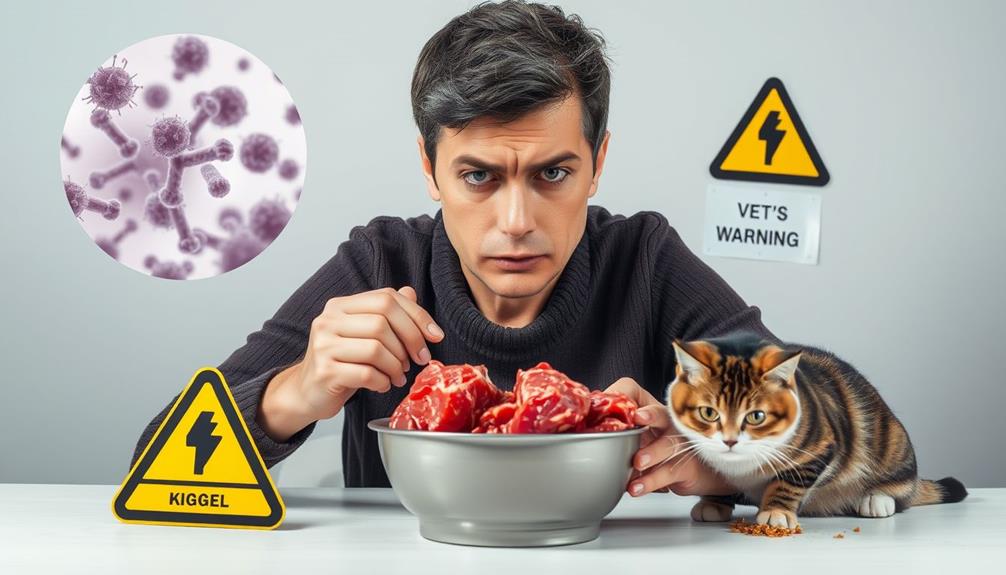
When considering a raw food diet for your cat, you need to be aware of the serious health risks involved.
Bacterial contamination from pathogens like Salmonella and E. coli can threaten both your cat's health and yours.
Additionally, without proper guidance, homemade raw diets mightn't provide the essential nutrients your cat needs, leading to imbalances that could harm them.
It's vital to guarantee that any diet, including raw, supports overall health, just like essential oils for respiratory health can aid in keeping your cat's body functioning at its best.
Bacterial Contamination Concerns
What risks come with feeding your cat a raw food diet? The concern for bacterial contamination is significant. Raw meat can harbor foodborne pathogens like Salmonella, E. coli, and Listeria, which can lead to severe infections in both your cat and your household members.
The CDC and AVMA strongly advise against raw diets due to these health risks. Additionally, similar to the importance of early detection in breast cancer through mammography guidelines, ensuring your cat's health requires vigilance against potential hazards in their diet.
Even though cats have shorter gastrointestinal tracts that may limit pathogen impact, they're not immune to serious health issues.
Here are three key points you should consider:
- Health Risks to Cats: Cats can suffer from severe infections due to contaminated raw meat, leading to illness or even death.
- Cross-Contamination: During meal preparation, raw meat can contaminate surfaces and utensils, posing a risk to household members, especially infants or pregnant women.
- Sanitation Practices: Proper handling and thorough cleaning of preparation areas are essential to mitigate the risks associated with raw diets.
In short, while raw diets may seem appealing, be aware of the risks and take necessary precautions to protect both your cat and your family.
Nutritional Imbalance Risks
Nutritional imbalance is a vital risk associated with feeding cats a raw food diet. You might think that a homemade raw diet is a natural choice, but these diets often lead to nutritional deficiencies, like a lack of thiamine. This important nutrient is vital for nerve and brain health, and its absence can result in serious health issues for your cat.
Additionally, just as individuals with BPD often experience intense emotional responses due to their unstable self-image, cats may also display behavioral changes if they don't receive the proper nutrients, which can affect their overall well-being.
While commercially prepared raw diets are designed to be balanced and meet the AAFCO nutrient guidelines, homemade versions can be imbalanced and fail to provide the necessary vitamins and minerals for your cat's overall health. Nutritional imbalances can adversely affect your cat's metabolism and bone health, leading to long-term complications if not managed properly.
To make sure that your cat's diet is nutritionally adequate, it's vital to work closely with a veterinarian. They can help you formulate a raw food plan that meets your cat's specific needs and minimizes the risks associated with deficiencies.
Preparing a Raw Food Diet
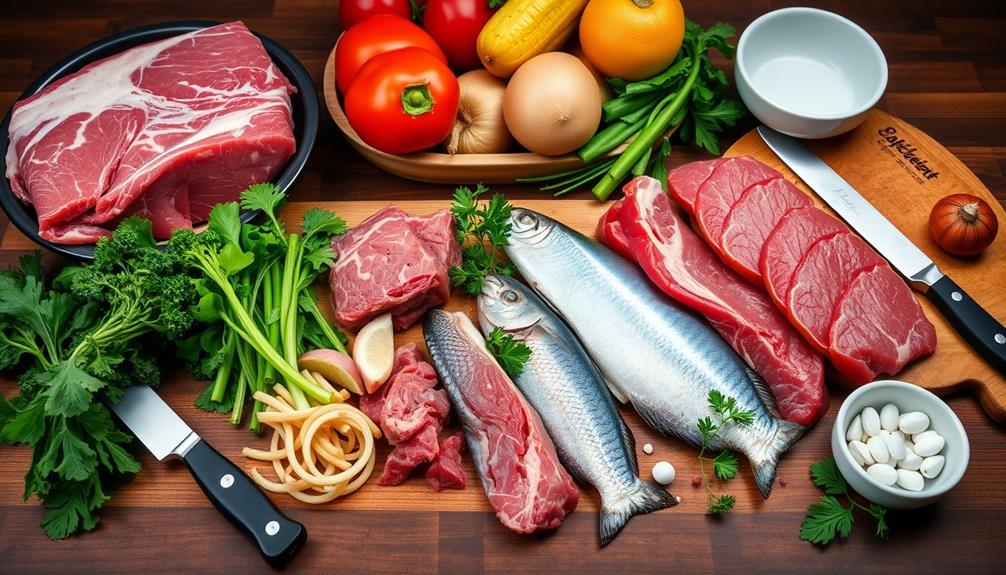
Preparing a raw food diet for your cat requires careful planning to guarantee you provide a nutritionally complete and balanced meal.
It's important to include high-quality ingredients and consult with a veterinarian to make certain you're meeting dietary needs. Just as with body piercings, where attention to hygiene and proper care is essential, maintaining cleanliness in your food preparation is critical to avoid contamination.
Here are three key steps to help you prepare raw:
- Select Quality Ingredients: Choose fresh, high-quality raw muscle meat, organ meats, and ground bones. Verify that all ingredients are sourced safely to avoid contamination. Remember, just as with piercing care and hygiene, the quality of your ingredients can greatly impact your cat's health.
- Implement Food Safety Measures: Sanitize your preparation areas, use gloves, and store raw ingredients correctly to prevent foodborne pathogens like Salmonella and E. coli. Regularly clean tools such as knives and cutting boards to minimize cross-contamination.
- Consider Supplements: To meet AAFCO guidelines and provide a complete and balanced diet, you may need to incorporate specific supplements. A veterinarian or animal nutritionist can help you identify the right additions for your cat's health.
Transitioning to a Raw Diet
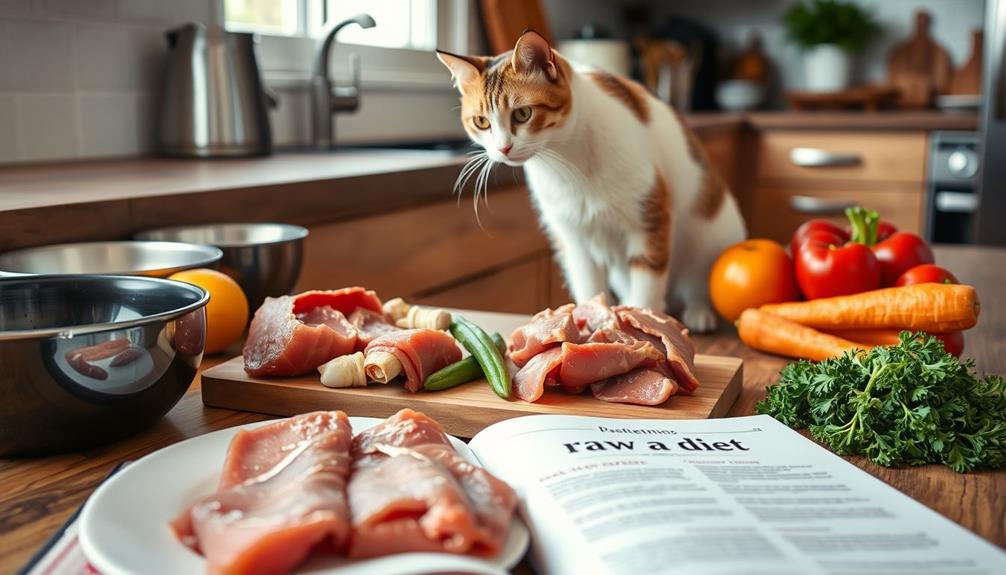
Once you've prepared a raw food diet for your cat, the next step is getting them accustomed to this new way of eating. A gradual shift over 7-10 days is key to minimizing digestive upset.
It's important to take into account your cat's overall health and any specific dietary requirements they may have, especially if they're older or have existing health conditions. Start with a mix of 75% old food and 25% raw food for the first three days. From days 4-6, adjust to a 50-50 split. Then, move to 25% old food and 75% raw food for days 7-9. By day 10, aim for a complete switch to 100% raw diet.
However, be flexible—if your cat shows signs of discomfort or refuses to eat, extend the adjustment period. Monitoring your cat's response is essential, as every cat adapts differently based on their individual preferences and digestive systems.
Throughout this process, it's wise to consult with a veterinarian, who can offer guidance on dietary needs to guarantee the new diet meets your cat's nutritional needs and address any health concerns that may arise.
With patience and attention, you can successfully shift your cat to a raw diet, promoting their overall health and well-being.
Commercial Raw Food Options
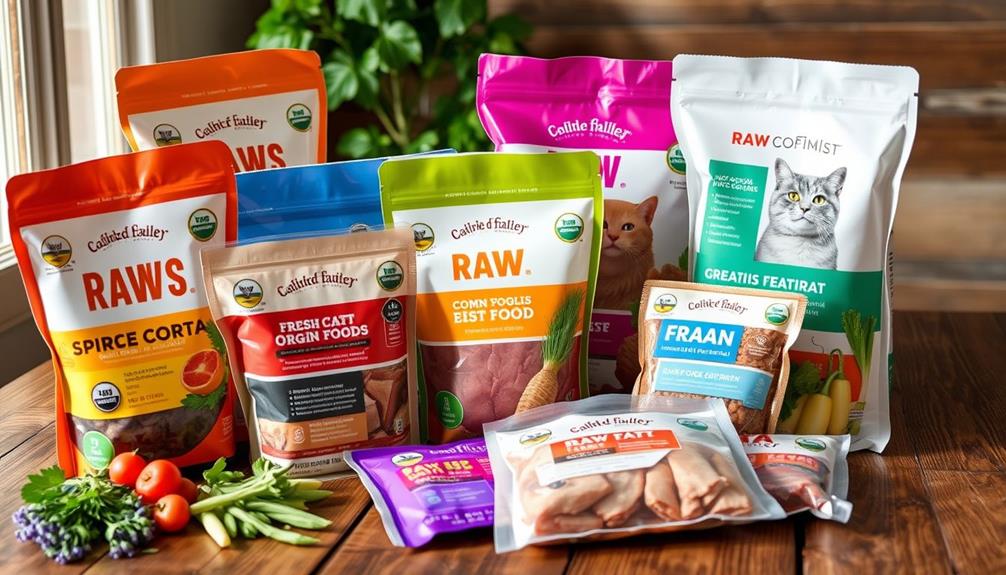
When considering a raw food diet for your cat, commercial raw food options can be a convenient and safe choice. These products are formulated to meet AAFCO guidelines, guaranteeing they provide complete and balanced nutrition for your feline friend.
Many reputable brands, like Stella & Chewy's and Primal Pet Foods, offer frozen or freeze-dried raw diets that help maintain the nutritional integrity of the ingredients while minimizing the risk of foodborne pathogens.
Additionally, it's crucial to acknowledge that just as with other dietary choices, consultation with knowledgeable professionals can contribute to your cat's overall health and well-being, similar to the importance of advance care planning in elderly care.
Here are three key benefits of choosing commercial raw food options:
- Nutritional Balance: These diets typically contain a mix of raw muscle meat, organ meat, and ground bone, closely mimicking a cat's natural diet.
- Safety Protocols: Commercial raw diets undergo rigorous safety testing and are produced in facilities that adhere to strict food safety protocols.
- Veterinary Guidance: It's wise to consult with your veterinarian when selecting a commercial raw food option to guarantee it aligns with your cat's specific health needs.
Alternatives to Raw Diets
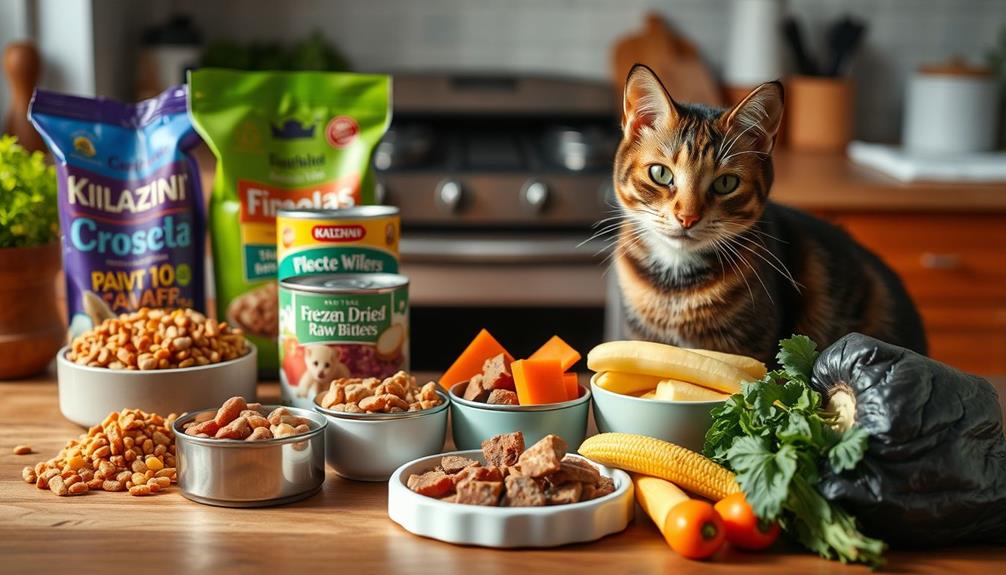
If you're looking for alternatives to a raw diet for your cat, there are several nutritious options that can meet their dietary needs. High-quality wet foods are a fantastic choice, as they offer high protein and moisture levels, aiding in hydration and digestion without the risks associated with raw feeding.
These wet foods are often formulated to meet AAFCO standards, guaranteeing they provide complete and balanced nutrition.
Another option is home-cooked meals, which allow you to control the ingredients your cat consumes. However, you'll need to carefully plan these meals to ensure they're nutritionally complete and meet all of your cat's dietary requirements.
Freeze-dried options also serve as a great alternative, as they maintain the nutritional benefits of raw food while minimizing handling issues and reducing the risk of bacterial contamination.
These options are convenient to store and prepare, making them practical for busy pet owners.
When selecting any alternative diet, always verify it meets AAFCO standards for complete and balanced nutrition, so your feline friend stays healthy and happy.
Frequently Asked Questions
Why Don T Vets Recommend a Raw Diet for Cats?
Vets don't recommend raw diets for cats because of foodborne pathogens and potential nutritional imbalances. They emphasize the risks to both pets and humans, suggesting commercially prepared options that meet established dietary standards instead.
What Raw Foods Are Safe for Cats?
Imagine your cat prowling like a wild hunter. You can safely feed them fresh chicken, turkey, or fish. Don't forget nutrient-rich organ meats and ground bones, but always guarantee they're sourced safely and prepared properly.
Do Raw Fed Cats Need Supplements?
Yes, raw-fed cats often need supplements to guarantee they get all essential nutrients. Taurine, vitamin E, and certain B vitamins might be lacking in homemade diets, so consulting a vet for tailored advice is vital.
Do Cats Live Longer on a Raw Diet?
While some believe a raw diet could help your cat live longer, the evidence is limited. Balanced nutrition plays an essential role, so make certain their diet meets all their needs for peak health and longevity.
Conclusion
In the world of feline nutrition, a raw food diet can be a double-edged sword. While it offers potential benefits, it also carries risks that can't be ignored. If you decide to venture into this territory, guarantee you do your homework and prioritize your cat's health. Remember, a happy, healthy kitty is worth their weight in gold. So, whether you choose raw or another option, make certain it fits your furry friend's unique needs!

